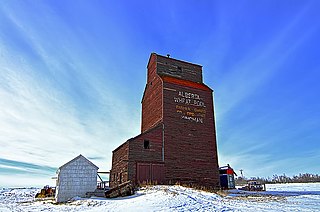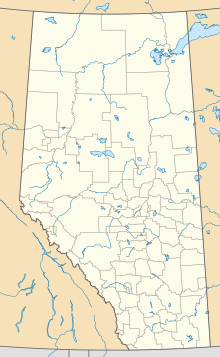
Kingman is a hamlet in central Alberta, Canada within Camrose County. It is located approximately 27 kilometres (17 mi) north of Camrose and has an elevation of 740 metres (2,430 ft).

Tomahawk, Alberta is a hamlet in Alberta, Canada within Parkland County. It is located on Highway 759, northeast of the Town of Drayton Valley.
Marlboro is a hamlet in west-central Alberta, Canada within Yellowhead County. It is located on the Yellowhead Highway, approximately 25 kilometres (16 mi) west of Edson. Sundance Provincial Park is located northwest of the hamlet.
La Glace is a hamlet in northern Alberta, Canada within the County of Grande Prairie No. 1. It is located along Highway 59 between Sexsmith and Valhalla Centre and has an elevation of 735 metres (2,411 ft).
Round Hill is a hamlet in central Alberta, Canada within Flagstaff County. It is located on Highway 834 approximately 29 kilometres (18 mi) northeast of Camrose and has an elevation of 740 metres (2,430 ft).
Benalto is a hamlet in central Alberta, Canada within Red Deer County. It is located approximately 13 kilometres (8.1 mi) west of the Town of Sylvan Lake. Benalto is also recognized by Statistics Canada as a designated place.
Canyon Creek is a hamlet in northern Alberta, Canada within the Municipal District of Lesser Slave River No. 124. It is located on Highway 2, approximately 234 kilometres (145 mi) east of Grande Prairie.
Clandonald is a hamlet in central Alberta, Canada within the County of Vermilion River. It is located approximately 28 kilometres (17 mi) north of Highway 16 and 58 kilometres (36 mi) northwest of Lloydminster.
Flatbush is a hamlet in northern Alberta, Canada within the Municipal District of Lesser Slave River No. 124. It is located 3 kilometres (1.9 mi) west of Highway 44, approximately 135 kilometres (84 mi) northwest of Edmonton.

Fort Kent is a hamlet in central Alberta, Canada within the Municipal District of Bonnyville No. 87, located on Highway 28 approximately 32 kilometres (20 mi) southwest of Cold Lake.
Grassland is a hamlet in northern Alberta, Canada within Athabasca County. It is on Highway 63, 151 kilometres (94 mi) northeast of Edmonton.
Joussard is a hamlet in northern Alberta within Big Lakes County. It is 2 kilometres (1.2 mi) north of Highway 2, approximately 83 kilometres (52 mi) west of Slave Lake.
Meeting Creek is a hamlet in central Alberta, Canada within Camrose County, located 1 kilometre (0.62 mi) west of Highway 56, approximately 38 kilometres (24 mi) south of Camrose.

Mulhurst Bay, or Mulhurst, is a hamlet in central Alberta, Canada within the County of Wetaskiwin No. 10. It is located 8 kilometres (5.0 mi) northwest of Highway 13A, approximately 38 kilometres (24 mi) southwest of Leduc.
Pibroch is a hamlet in central Alberta, Canada within Westlock County. It is located 2 kilometres (1.2 mi) west of Highway 44, approximately 83 kilometres (52 mi) northwest of Edmonton.
Pickardville is a hamlet in central Alberta, Canada within Westlock County. It is located 2 kilometres (1.2 mi) west of Highway 44, approximately 62 kilometres (39 mi) northwest of Edmonton.
Rochester is a hamlet in northern Alberta, Canada within Athabasca County. It is 3 kilometres (1.9 mi) east of Highway 2, 93 kilometres (58 mi) north of Edmonton.
Tees is a hamlet in central Alberta, Canada, within Lacombe County. It is located 1 kilometre (0.62 mi) north of Highway 12, approximately 40 kilometres (25 mi) northeast of Red Deer.
Vimy is a hamlet in Westlock County in Central Alberta, Canada. It is located 1.4 kilometres (0.87 mi) east of Highway 2, approximately 59 kilometres (37 mi) north of Edmonton.
Whitelaw is a hamlet in northern Alberta, Canada within the Municipal District of Fairview No. 136. It is located 2 kilometres (1.2 mi) north of Highway 2, approximately 114 kilometres (71 mi) northeast of Grande Prairie.






